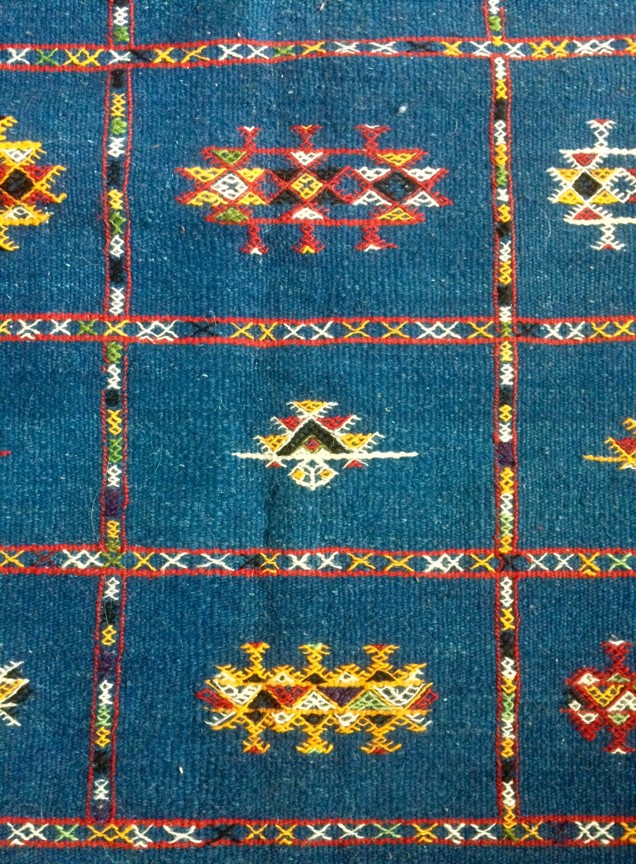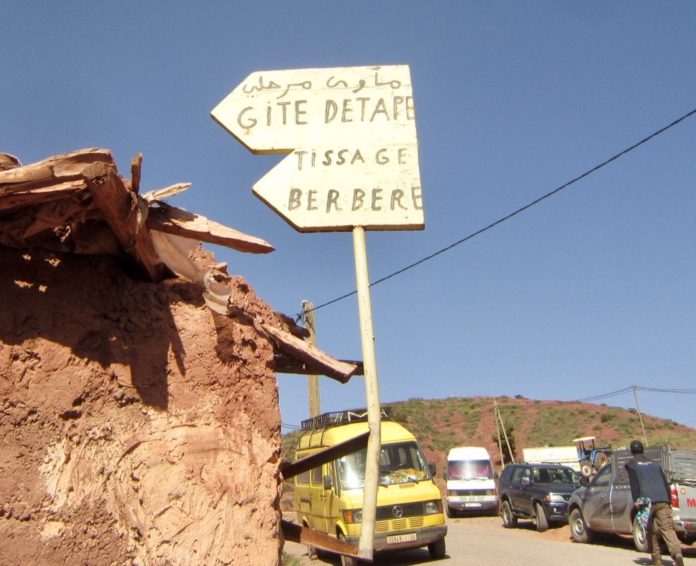This essay is part of a dossier on The Maghreb after Orientalism.
by David Fieni
In his free verse anti-manifesto from 1976, Class Warrior – Taoist Style, Abdelkebir Khatibi warns readers against the dangers of turning metaphor into an idée fixe, challenging them to “hold to poetic knowledge without creating a fetish” (2017: 17). Such a formulation sums up one core impulse of Khatibi’s body of work, which activates the opaque force of language in the elaboration of a decolonial idiom that shutters back and forth between critique and poetics. This injunction also offers a productive frame for understanding a central task of Edward Said’s Orientalism, namely the imperative of detailing the violence involved in the figuration of worldly experience. Thinking through the legacy of Said’s groundbreaking study forty years after its publication, and particularly the book’s continued relevance both in the Maghreb and for critical work about the Maghreb, prompts us to ask how critique today can resist turning knowledge about the Maghreb – poetic or otherwise – into a fetish. In what follows, I work through some of the ramifications of this confluence of Khatibi and Said regarding figuration and knowledge as it relates to the disciplines of Francophone studies, comparative literature, and postcolonial criticism.
In “Counterpoint and Double Critique in Edward Said and Abdelkebir Khatibi: A Transcolonial Comparison,” Françoise Lionnet makes a welcome call for a renewed interest in Khatibi’s work for comparative critique, and more specifically, for the study of postcolonial and transnational literatures. She reexamines Khatibi’s critical writing, focusing on the key chapters in Maghreb Pluriel (Plural Maghreb), alongside the work of Edward Said. Lionnet begins by comparing Khatibi’s “double-critique” and Said’s practice of “contrapuntal reading,” but ends with an appraisal of the two authors’ different approaches to the critical practice of contrepoint. She argues that while both thinkers should be lauded for having opened new avenues of reading, rendering minor or marginalized voices audible amidst the din of colonial and neo-colonial babble, Khatibi ultimately offers a more convincing model for critique:
Therein I believe lies the principal difference between Khatibi and Said: for although Said is interested in how “a particular type of research and knowledge begins to build up” allowing for the study of culture “as contrapuntal ensembles” of hybrid identities (Said, 1993: p. 52), ultimately he can only address their common ground of translatability, whereas Khatibi wants to allow for an as-yet-unthought exteriority beyond the “archeology of silence” that represses other languages, genders, and peoples in their unheard difference. For Said, what is translatable is that which is discernible within the overall arrangements of literary and musical high culture as the site of a historic face-off between the imperial west and those who resist its claims in their “disparities and discrepancies” (Said, 1993: p. 114) which must eventually come to order and harmony, as in the musical interplay or counterpoint of the concert performance. (Lionnet 2012: 404, original italics)
Whereas Said’s model of contrapuntal reading, first announced at the end of Culture and Imperialism (1993), would seem to betray his excessive concern for “high culture” which would somehow determine what has value for academic research, Khatibi’s understanding of contrepoint, Lionnet points out, takes its lead not from Western classical music, but rather from the work of weaving and sewing, such as that done by Moroccan carpet makers. While such a claim does have a certain appeal—that Khatibi’s weaving metaphor draws upon local practices while honoring women’s work—Lionnet’s contention here also dismisses what is distinctive about Said’s understanding of counterpoint, namely its capacity to elaborate the very historical processes through which knowledge is “built up” in specific languages but not in others.
Indeed, there are valuable reasons to pursue the kind of argument Lionnet hints at here. For instance, one could read Khatibi’s insistence on the contrepoint specific to Moroccan carpet making as an invention of technique that would not simply be borrowed from so-called “Western” techniques or procedures of thought (from Nietzsche to Derrida, say). In this scenario, one might understand the way that Khatibi articulates his thought in relation to the work of Moroccan women who weave carpets not as a mode of filling “foreign” theory with local content, but rather as a way of elaborating a practice of portable reading. Yet Lionnet does not base her argument on such an interpretation. Instead, she simply misreads Said’s notion of contrapuntal critique and offers Khatibi’s contrepoint of weaving in its place as a self-evidently superior critical model. The question thus becomes: are Khatibi’s transversal intersemiotics—developed through readings of carpets, tattoos, literature, calligraphy, proverbs, and jokes from Moroccan and Islamic contexts—only good for reading Moroccan, Maghrebi, minor, or marginal cultural artifacts? In other words, can Arab(ic), Islamic, or Maghrebi theory travel? Can it travel to the self-appointed “centers” (the metropole or capital)—and there constitute itself as an exilic territory? (Fig. 1)

While there may be any number of contingent reasons for preferring the contrepoint of a carpet to that of a fugue, I am not entirely convinced that there is anything inherent to a beautiful Moroccan carpet that would necessarily make it a better theoretical model for transnational and transcolonial comparison than a Bach fugue. The inverse of such an affirmation would also of course be true: namely, that nothing guarantees that the hermeneutic resources of a Bach fugue would be superior to those contained within a Moroccan carpet. After all, in his text on the intersemiotics of such carpets, Khatibi set out “to study this imagination in the space of the carpet, as one studies a page of Aristotle, with the same seriousness, exposing aesthetic theories dedicated to the imaginary and the symbolic” (d’étudier cette imagination dans l’espace du tapis, comme on étudie une page d’Aristote, avec le même sérieux, en exposant des théories esthétiques, consacrées à l’imaginaire et à la symbolique (Merino 2013: 123-4)).
This constellation of texts points in the direction of a contrapuntal double critique, which would short circuit close reading with distant reading, making selective use of the kind of poststructuralist tools that Khatibi himself develops and repurposes, but would not stop there. Rather, such a critique would instead continue to listen for the “unheard differences” that are both interior and exterior to the texts and cultural products under consideration. It is Said, I would argue, even more than Khatibi who prompts us to take this historical step back from the object of our analysis. A valuable instance of this kind of reading can be seen in Aamir Mufti’s Forget English! Orientalisms and World Literatures (2016), which understands Said’s philology as a kind of contrapuntal close reading that emphasizes precisely the processes of historical sedimentation which operate at multiple levels within the text and outside of it.
Taking a contrapuntal double critique seriously would mean examining the textual self-disappropriation that Khatibi discusses, which also animates his experiments with simultaneity, with distance and closeness. It would also mean stepping back to think about the continuing predominance of dispossessed languages and discourses which Said, as well as Khatibi himself, both foregrounded in their work.[1] So instead of a “bad,” Western counterpoint (Said and Bach) versus a “good,” Maghrebi contrepoint (Khatibi and the Moroccan carpet), we have instead two competing modes of simultaneity. On the one hand, there is Khatibi’s singular kind of espacement, what he calls “le tissage par la syntaxe” (weaving through syntax), a practice more on the side of superimposition, of interference or static, capable of opening up an exilic form of “hostage” within the text. On the other hand, we have Saidian simultaneity, which is perhaps more temporally and historically oriented, less about resolution, to be sure, than perpetual disruption. Like exile, the simultaneity of Saidian counterpoint plays along the seams of what he calls an “unhealable rift” (Said 2000: 175), concerning itself with the historical dimensions of planetary relations. “Exile,” Said writes, “is life led outside habitual order. It is nomadic, decentered, contrapuntal; but no sooner does one get accustomed to it than its unsettling force erupts anew” (Said 2000: 186).
So we might therefore say that Said’s notion of counterpoint is primarily but not exclusively temporal-historical in nature, bound to musical forms of expression, which serve as a theoretical point of departure. It imagines renewable reading practices that can attempt to account for mobile structures of silencing as well as echo-chamber effects and divergent variations on multiple themes that seem to all be happening at once, although they are in fact each played in accordance with their own distinct time signatures. This critique—or shape of critique—occurs alongside and at the same time as Khatibi’s somewhat more spatial understanding of counterpoint, perhaps more akin to weaving or sewing, and, in particular, articulated in places in relation to the art of Moroccan rug making. What, then, might a contrapuntal double critique look and sound like?
Khatibi’s own reflections on exile, francophonie, pseudonymy, and syntax can open up further paths of such future reading. Let us first consider what he has to say about the linked questions of literary and linguistic forms of hostage, hospitality, and self-dispossession. In “The Name and the Pseudonym,” Khatibi examines the particular case of “Francophone writers”:
The literature whose name we bear, whatever our origin, citizenship, or nationality, has been forced, through a particular poetic exercise and work, to constitute a territory that belongs to nobody, but which politics seize like private property, and so well that in certain public sessions one gets the rather curious sense that the “Francophones” are a community of hostages. But who and what holds them hostage? (Khatibi 2008: 115-6)
Francophone writers write under the constraint of the utopian condition of “their” language. This is a pre-existing condition of so-called “Francophone” literature, which in turn becomes a point of arrival for a philosophical meditation on languages in the plural. For Khatibi, the Francophone writer is caught in an interstitial space, between the no-where of utopia and the political instrumentalization of languages. Instead of answering the questions he asks at the end of this passage, Khatibi evokes the “weaving through syntax” that allows him to “widen the space of hospitality” in his “own” text:
It is syntax that is my aim, my point of connection and the wake I leave in the time of each vocable. Syntax: a unification in movement of the target language. Thanks to this simultaneous translation, to this process of grafting, I record what returns to me from memory without forced reservation. In this way, I investigate the forces of silence between languages, the erasure of traces and their rest stops, their becoming ash. So if I sing the praises of syntax, it is because it widens the space of hospitality where the writer is received in his own text as a guest, in the shadow of the writer. (2008: 116)
For Khatibi, syntax is the privileged site of poetic procedures: internal, simultaneous translation, the grafting of diverse elements, and “the erasure of traces.” It allows him to bypass the impasses of philological sedimentation and the symbolic politicization of language. He confesses to feeling “an affinity with a language . . . stronger than the sentiment of belonging” (117), and in general, his work aims to sabotage any deterministic relationship between language and ownership, between language and property, provoking a perpetual rupture in the pact between language and the nation. Writing in the “language of the other” is always an act of “self-disappropriation” for Khatibi, but also a way of asserting that “language is not property.” One could say that Khatibi here agrees with Derrida and the notion of “monolingualism” being a “prosthesis” for an origin that is always irrecuperable and lost to memory and language. But Khatibi describes, performs, and traces the seams that mark the disappropriation of this monolanguage, moving from “monolanguage” to “bi-language” and beyond.
But we cannot stop here, because within the synchronic virtual silences of these texts we find diachronic silences, determined by the historical process of the silencing or accumulation of languages and knowledge practices. This process is precisely what, in a forthcoming book, I explore under the title of Decadent Orientalisms: a colonial politics that institutes the study of comparative languages and literatures, including those of “the Orient,” under the very sign of these languages’ supposed decadence, and, ultimately, their disappearance. This kind of Orientalism is both descriptive and prescriptive: an apparatus that functions by breaking down, that integrates only to disintegrate. The ambivalent nature of this apparatus prompts us to also pay attention to the philological context at work here, even when reading texts as fragmented and radically decentered as those of Khatibi. The armes miraculeuses (miraculous weapons, Césaire 1970) of the Khatibian text “record” the memory of other languages, and the author “investigate[s] the forces of silence between languages.” The fact that this investigation takes place in French remains a significant element of the inscription of silence in history and in the world that this text performs, however. Are dialectal Arabic or Tamazight at liberty to circulate in the same global spaces and think according to the same techniques or procedures as can French? The virtual apparition of other languages and signifying practices in the Francophone text coincides precisely with their marginalization, with their virtualization. The disappropriation Khatibi writes about is thus haunted by the politics of assimilation and the colonial notion of francophonie as instances of attempts at diversity in French. The French language remains a world in itself, a “littérature-monde” (to allude to the title of the 2007 book by Michel Le Bris and Jean Rouaud), just as “Global English” or “Anglophone Literature”—rubrics that serve to satisfy the demands for diversity put on the canon. This means that rendering French heterogeneous and non-identical to itself is inseparable from a homogenization of textual practices and procedures of thought into the “globalized” form of a monolingual “world literature.” Should we borrow a rhetorical move from Derrida, and boldly affirm that Khatibi is in fact the most “minor-transnational” of all Francophone writers? (This performatively ironic assertion about Khatibi’s “identity” comes from Derrida’s lecture on “la francophonie outside of France,” published in Le Monolinguisme de l’autre, where he declares himself “the most Franco-Maghrebian” of the pair (Derrida and Khatibi), and possibly even “the only Franco-Maghrebian” (Derrida 1996: 29, original italics).) After all, from the perspective of the hexagon or North American French studies, Khatibi’s texts might be said to satisfy a certain demand for otherness, opening out onto the Arabic language, Moroccan popular culture, and Islamic mystical traditions without requiring any Arabic whatsoever from the critic. Such a claim is less a critique of Khatibi than of certain critical approaches to Francophone literature in the Maghreb. Thus the challenge of reading Khatibi today, and, by extension, the challenge for a field such as Francophone studies, is to acknowledge the extraordinary diversity of rhetorical techniques employed in these texts without celebrating this as diversity tout court, without fetishizing this poetic knowledge. As with Khatibi and Francophone studies, so, too, with comparative literature.
Another way of framing this argument is that Arabic calligraphy, darija, Tamazight, and other local practices (tattooing, proverbs, jokes, etc.)—those things that serve as the poles that Khatibi uses to make French or Francophone practices render their static and generate the opacity or interference of the intersign—may well have a higher redemption value in the “world republic of letters” when uttered in French. That is, the self-disappropriation that Khatibi transforms into something like a virtue of literary asceticism borders on complicity with the forms of disappropriation that are also still very much operative in the world literary system, albeit in a more brutal and far less theoretical way. The asymmetrical structures of the institutions of world literature, relating to, among other things, values attached to certain so-called “global” languages, the system of consecration by which an author from the margins must be recognized and praised by writers, critics, and publishing houses at the center (Paris, London, New York, etc.) continue to regulate who reads and writes what and in what languages. I do not point out the obvious facts of the situation in order to pass judgment on Francophone writers from the Maghreb such as Khatibi. Quite the opposite: I would say that it is precisely because Khatibi has taken this problematic of language conflict further than any other writer of his generation that we must not stop at a celebratory appraisal of his singular rhetorical inventions—which is a common strategy when reading writers “from the margins”—nor is it advisable to transform this singularity into a theoretical model to follow.
Khatibi himself urges us to do the same. Likewise, Said did not turn contrapuntal reading into a critical fetish the way that Lionnet wants to do with contrepoint. One is reminded here of the scarcely hidden Orientalism at the heart of Pascale Casanova’s La république mondiale des lettres (World Republic of Letters 1999), which begins with a discussion of Henry James’s “The Figure in the Carpet,” which Casanova uses to illustrate the critical revelations that can follow a change of one’s vantage point, yet is cited in a book that repeatedly reinforces the centrality of Paris to the entire planetary institution of literature. In contrast, Said insisted that counterpoint function as a relational operation one performs on the archive, a means of radically decentering the T-O map of Orientalist faith. Instead of taking hard-won poetic knowledge as a fixed point of departure for further theorization about the Maghreb, Khatibi and Said prompt us to trace the figures projected onto the Maghreb (by both Orientalist and purportedly anti-Orientalist writers) back to the violence and erasure that these figures simultaneously elide and generate. Such is one possible path through the epistemological minefield that Orientalist knowledge has left scattered in language and thought.
The kind of “poetic knowledge” that Khatibi offers, then, is a disruptive force that operates according to the relational logic of “survival in transformation” (Khatibi 1983: 17). Against this, Orientalism does not simply put forth a figure or a set of figures, but rather sets in motion an epistemological apparatus that is constantly adapting to changing conditions of geopolitics and cultural economies of representation and knowledge production. This is one cause of what I call the decay of Orientalism: it must retain a core set of axioms while at the same time changing its modes and tenor. Which brings us to perhaps the most urgent point of all: that Orientalism itself must not become a monolithic theoretical model, but must rather be leveraged as a relational tool responsive to adaptations and even cooptations of actors and agents of settler-colonialism and neo-imperialism in an Orientalist mode. If thinking about Said’s larger project now in relation to the Maghreb reveals the ways that Orientalism itself is a metaphor, it also cautions us to wield the figurative violence it produces without turning it into a fetish.
Measuring the core impulse of Orientalism against the historical mutations it undergoes is one way of renewing the potential of the decolonial project articulated by both Said and Khatibi. But one may also measure other modalities of relation against Orientalism; Edouard Glissant’s elaborations of the philosophies and poetics of relation spring immediately to mind (1990; 2009), as do other examples, such as Lionnet and Shu-mei Shih’s Minor Transnationalism (2005), or the transcolonial Maghreb elaborated by Olivia C. Harrison in her book (2016) and her contribution to this dossier. In its jarring mélange of Marx and Lao Tzu, playing with Sufi metaphors in French, Khatibi’s Class Warrior – Taoist Style engineers a mutually disorienting mode of relation that demonstrates one escape route from the postcolonial impasse of Francophonie haunted by revenant Orientalism. Bypassing France in all ways but the language of the poem, Khatibi’s verse articulates a perpetual revolt in a language that effects a disappropriation on multiple planes: of French and Arabic poetic traditions, of the committed decolonial writer’s fetishized Marxian verbiage, and of language as a guarantor of identity. Khatibi’s turn to Chinese Taoism engineers modalities of poetic knowledge that imagine ways of short-circuiting the master metaphors of Orientalism. In a similar vein, contemporary Moroccan Arabic haiku turn to Japanese poetics to defamiliarize Arabic poetic form while inventing a new ecopoetic idiom. Both instances take readers into emerging possibilities of a new kind of contrapuntal reading. The Arabic haiku movement, which has flourished especially in Oujda (Nasri 2017), a city often considered to be on the margins of Moroccan cultural production, represents a contemporary instance of the kind of “poetic knowledge” articulated in Khatibi’s poem. Haiku by poet Sameh Derouich perform a similar self-disappropriation of Arabic poetics while improvising an ecopoetics of literary, linguistic, and environmental relation. Derouich’s work is just one example of cultural production in the Maghreb flourishing blissfully beyond Orientalist master tropes and epistemological prisons.
Let me end, then, with two poems by Derouich which resonate, albeit in a quietly vital way, with what Abdellatif Laâbi called the “seismic pathways of freedom” of future poetry (1969: 43). The first haiku deliberately blindfolds the poet’s eyes to figurative language, and the second intuits something like the political will of the social from falling leaves.
With my metaphor blindfolded ma‘suba al-majaz
I look at you, anthuru ilayk
Oh almond blossoms! ya azhar al-lawz
(2016: 55)
Without authorization, bidun tarkhis
Autumn leaves tatajamharu
Assemble. awraq al-kharif
(24).[2]
By disabling poetic figuration and its distortions, Derouich stages the event of poetic knowledge as an elucidation of complex experience, where private and public, familiar and unfamiliar, mediated and immediate, words and things traverse each other. If the first poem offers a moment of lucidity that is both open to the reader and utterly inaccessible, the second haiku affirms the primacy of this non-figurative lucidity. Whatever aesthetic or political theory one wishes to milk from the almond blossoms or extract from the autumn leaves, these poems suggest, will necessarily be derivative and secondary. In this way do Derouich’s poems set flowers and trees native to the Mediterranean into a naturalized poetic form bereft of any sentimental indigenizing theory.
David Fieni is Assistant Professor of French at the State University of New York, Oneonta. He is the author of Decadent Orientalisms: Configuring the Decay of Colonial Modernity in French and Arabic (forthcoming 2019) and translator of Laurent Dubreuil’s Empire of Language (2013). Fieni has co-edited special journal issues on “The Global Checkpoint” and on the Moroccan writer Abdelkebir Khatibi. His work has appeared in diacritics, boundary 2, PMLA, and Expressions Maghrébines.
References
Casanova, Pascale. 1999. La république mondiale des lettres. Paris: Seuil.
Césaire, Aimé. 1970. Les armes miraculeuses. Paris: Gallimard.
Derouich, Sameh. 2016. 100 Haiku. (n.p.): Literary Convoy Publications.
Derrida, Jacques. 1996. Le monolinguisme de l’autre, ou la prothèse d’origine. Paris: Galilée.
Glissant, Édouard. 2009. Philosophie de la relation: poésie en étendue. Paris: Gallimard.
—. 1990. Poétique de la relation. Paris: Gallimard.
Harrison, Olivia C. 2016. Transcolonial Maghreb: Imagining Palestine in the Era of Decolonization. Stanford: Stanford University Press.
Khatibi, Abdelkebir. La blessure du nom propre. Paris: Denoël, 1974.
—. 2017. Class Warrior–Taoist Style. Trans. Matt Reeck. Middletow: Wesleyan University Press.
—. 1995. Du signe à l’image: le tapis marocain, Casablanca: Lak International.
—. 1995. “Incipits.” Du bilinguisme. Ed. Jillal Benanni. Paris: Denoel.
—. 2010. “The Language of the Other: Testimonial Exercises,” Introduction by David Fieni, trans. Catherine Porter. PMLA, 125.4, October (2010), 1006.
—. 2008. Œuvres de Abdelkebir Khatibi, III: Essais. Paris: La Différence.
Laâbi, Abdelatif. 1969-1970. “Les singes éléctroniques.” Souffles 16-17. Casablanca: Editions les croisées des Chemins, n.d.
Lionnet, Françoise. 2011. “Counterpoint and Double Critique in Edward Said and Abdelkebir
Khatibi: A Transcolonial Comparison.” In A Companion to Comparative Literature, edited by Ali Behdad and Dominic Thomas, 388-407. Oxford: Wiley-Blackwell.
— and Shu-mei Shih, eds. 2005. Minor Transnationalism. Durham, NC: Duke University Press.
Merino, Leonor. “Pour Abdelkebir Khatibi: Le visage de la terre est déjà recouvert des yeux de tant de bien-aimés disparus.” Interview with Abdelkebir Khatibi. Abdelkebir Khatibi, intersigne, special issue of Expressions maghrébines, David Fieni and Laurent Dubreuil, eds. 12.1 (Summer 2013), 121-4.
Mufti, Aamir. 2016. Forget English! Orientalisms and World Literatures. Cambridge: Harvard University Press.
Nasri, Chourouq. 2017. “Poetry as Resistance: An Ecocritical Reading of Sameh Derouich’s Haiku.” Ikhtilaf: Journal of Critical Humanities and Social Studies. 1 (Fall): 59-69. http://identityanddifference.org/wp-content/uploads/2017/12/Chourouq-Nasri-Poetry-As-Resistance-Nasri.pdf
Said, Edward. 1993. Culture and Imperialism. New York: Knopf.
—. 1979. Orientalism. New York: Vintage Books.
—-. 2000. Reflections on Exile. Cambridge: Harvard University Press.
This essay includes material that has been translated and modified from David Fieni, “Désappropriation de soi et poétique de l’intersigne chez Khatibi,” Expressions maghrébines 12, no. 2 (2013): 1-17.
[1] One thinks immediately, for example, of Khatibi’s essay on Jacques Berque, “L’Orientalisme désorienté” from 1976, two years before Said’s Orientalism.
[2] The haiku in this collection appear in the original Arabic alongside translations into French, Spanish, and English. Mourad El Khatibi, Abdlekebir Khatibi’s nephew, did the translations into English. I have slightly modified the first translation and kept the second poem as published.




